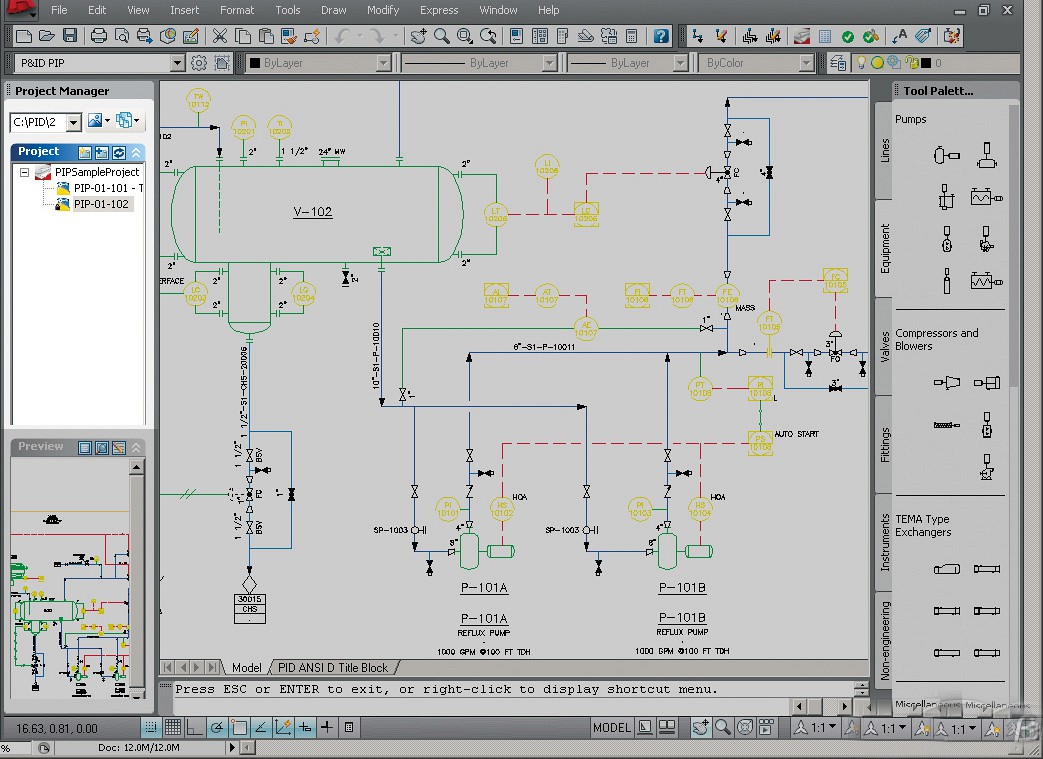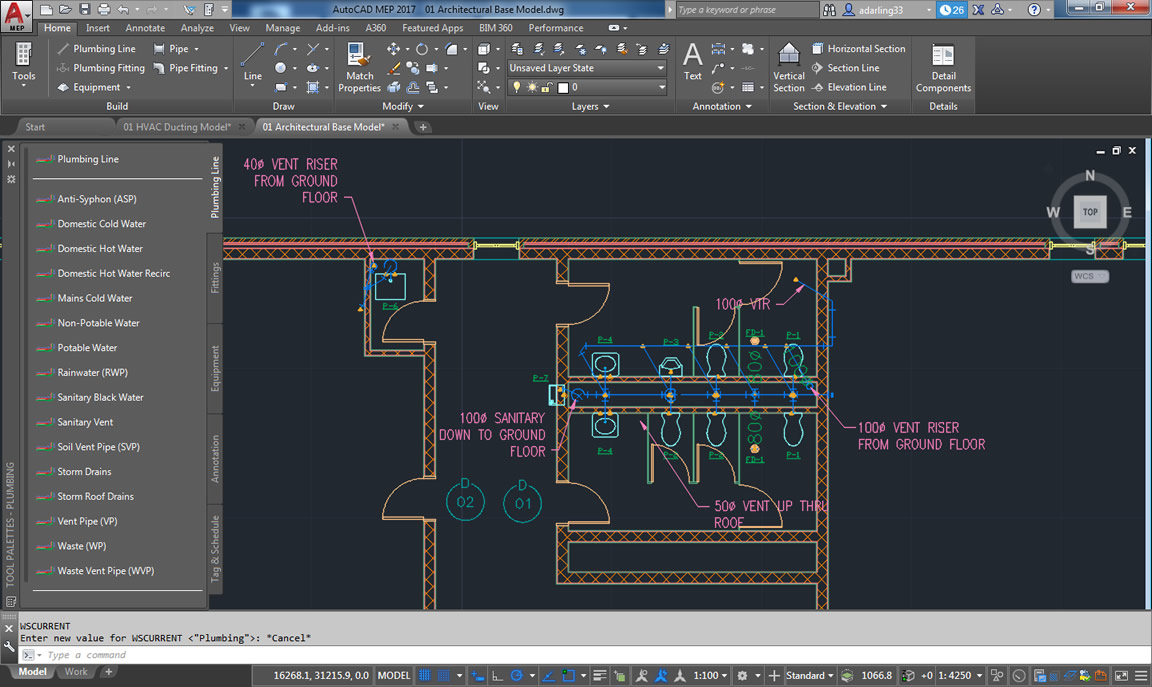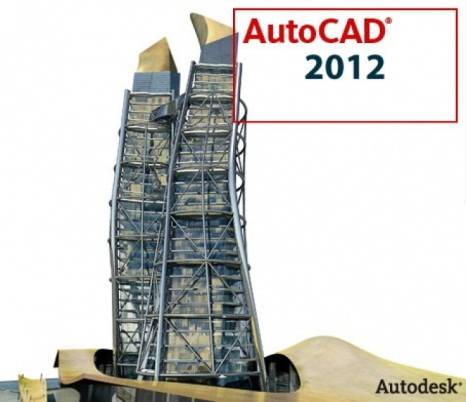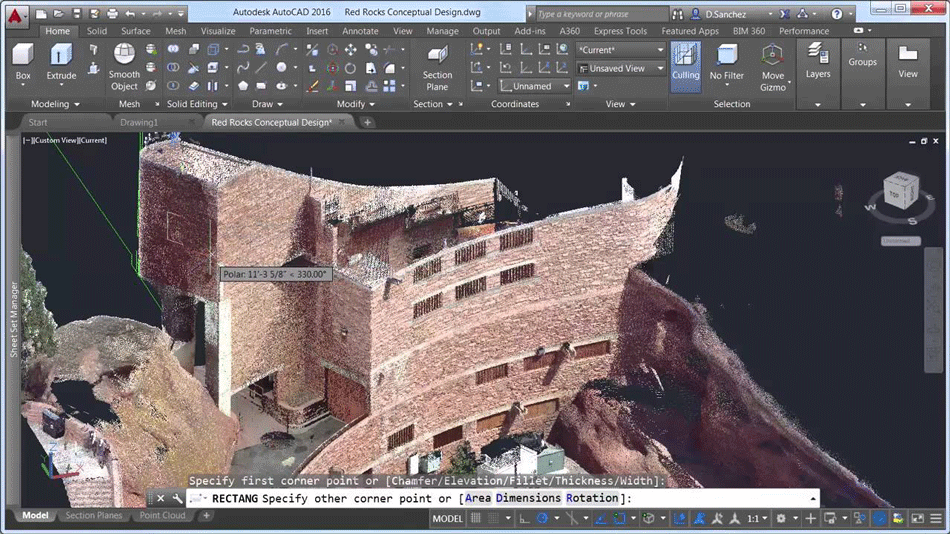AutoCAD- two- and three-dimensional computer-aided design and drawing system developed by Autodesk. The first version of the system was released in 1982. AutoCAD and specialized applications based on it are widely used in mechanical engineering, construction, architecture and other industries. The program is available in 18 languages. The level of localization varies from full adaptation to translation of reference documentation only. The Russian-language version is fully localized, including the command line interface and all documentation, except for the programming manual.
The Command Prompt, which has been gradually hidden behind updated graphical tools in recent versions, is now back in its usual place. Command line users appreciate the updated functionality of the standard tool in the new version.
As for editing drawings, this led to such innovations as direct changing of properties - now all changes to object parameters are immediately displayed on the screen, and not when the command is completely executed. Improved handling of complex patterns makes it easier to display parts with a large dynamic set of parameters.
Functionality
Early versions of AutoCAD operated with a small number of elementary objects, such as circles, lines, arcs and text, from which more complex ones were composed. In this capacity, AutoCAD has earned the reputation of an “electronic drawing board”, which remains with it to this day. However, on modern stage AutoCAD's capabilities are very wide and far exceed those of an “electronic drawing board”.
In the new version of the program you can edit the progress of several objects at the same time. The extended panel toolbar opens automatically by selecting any flyout item. Stretch and emboss functions now work more easily with complex geometric shapes, including cones.
The ability to import files and combine them with point clouds has been significantly expanded, and various formats are supported. Annotation annotations now allow new translucent fonts to be displayed across all images and control their rendering patterns independently of being bound to specific elements and layers.
In the new version of the program you can edit the progress of several objects at the same time. The extended panel toolbar opens automatically by selecting any flyout item. Stretch and emboss functions now work more easily with complex geometric shapes, including cones.
In the area of two-dimensional AutoCAD design still allows you to use elementary graphic primitives to obtain more complex objects. In addition, the program provides very extensive capabilities for working with layers and annotative objects (dimensions, text, symbols). Using the XRef mechanism allows you to split a drawing into multiple files for which different developers are responsible, and dynamic blocks expand the capabilities of 2D design automation for the average user without the use of programming. Since version 2010, AutoCAD has implemented support for two-dimensional parametric drawing.
The current version of the program (AutoCAD 2012) includes a full set of tools for complex 3D modeling(Solid, surface and polygon modeling are supported). AutoCAD allows you to obtain high-quality renderings of models using the mental ray rendering system. The program also implements 3D printing control (the modeling result can be sent to a 3D printer) and support for point clouds (allows you to work with 3D scanning results). However, it should be noted that the lack of three-dimensional parameterization does not allow AutoCAD to directly compete with middle-class mechanical engineering CAD systems such as Inventor, SolidWorks and others. AutoCAD 2012 includes the Inventor Fusion program, which implements direct modeling technology.
Development and adaptation tools
The wide distribution of AutoCAD in the world is due not least to its developed development and adaptation tools, which allow you to customize the system to the needs of specific users and significantly expand the functionality of the base system. A wide range of application development tools makes the basic version of AutoCAD a universal platform for application development. Based on AutoCAD, Autodesk itself and third-party manufacturers created a large number of specialized applications such as AutoCAD Mechanical, AutoCAD Electrical, AutoCAD Architecture, GeoniCS, Promis-e, PLANT-4D, AutoPLANT, SPDS GraphiCS, MechaniCS and others.
Dynamic blocks
Dynamic blocks are two-dimensional parametric objects with a customizable set of properties. Dynamic blocks provide the ability to save in one block (a set of graphic primitives) several geometric implementations that differ from each other in size, relative arrangement of block parts, visibility of individual elements, etc. Using dynamic blocks, you can reduce libraries of standard elements (one dynamic block replaces several regular ones). Also, the active use of dynamic blocks in some cases can significantly speed up production working documentation. Dynamic blocks first appeared in AutoCAD 2006.
Macros
Action Macros
Action Macros first appeared in AutoCAD 2009. The user executes a sequence of commands that are recorded using the Action Recorder tool. The recorded macro can be edited and saved, and subsequently transferred to the toolbar, or launched from a special menu.
Menu Macros
The user has the opportunity to create his own buttons, with which you can call a series of commands (macros) pre-recorded according to certain rules. Macros can include expressions written in DIESEL and AutoLISP.
DIESEL
DIESEL (Direct Interprietively Evaluated String Expression Language) is a string operating language with a small number of functions (28 functions in total). It allows you to generate strings that must have variable text depending on some conditions. The result is output as a string, which is interpreted by AutoCAD as a command. The DIESEL language is used primarily for creating complex macros as an alternative to AutoLISP. This language is of particular importance for the AutoCAD LT version, which lacks all programming tools, with the exception of DIESEL. This language first appeared in AutoCAD R12.
Visual LISP
AutoLISP
AutoCAD VBA
AutoCAD, starting with version R14, has introduced support for VBA (Visual Basic for Application). Unlike VisualLISP, VBA is a visual programming environment, but VBA applications work with AutoCAD only through ActiveX, and interaction with AutoLISP is very limited. The advantages of VBA are more complete ActiveX support and the ability to load DLL libraries.
Starting with AutoCAD 2010, the VBA development environment is not enabled by default. Autodesk is phasing out VBA support in AutoCAD in favor of .NET. .
ObjectARX
The ObjectARX SDK is an addition to the Microsoft Visual Studio development environment and contains special libraries, header files, examples and auxiliary tools designed to create programs that function exclusively in the AutoCAD environment. ARX applications can directly access the pattern database and geometry kernel. You can create your own commands, similar to standard AutoCAD commands. The ObjectARX package was first implemented for AutoCAD R13; previously there were ADS (for AutoCAD R11) and ARX (for AutoCAD R12) packages similar in purpose. The ObjectARX version designations are the same as the AutoCAD versions for which this package is intended. Programs created for one specific version of AutoCAD are not compatible with other versions. The compatibility problem is usually solved by recompiling the program in the appropriate version of ObjectARX.
.NET
COM
Undocumented ability to work with AutoCAD in all programming languages that support COM technology. The most popular programming language among developers is Delphi.
Supported Operating Systems
AutoCAD is certified to run on the Microsoft Windows family of operating systems. Version 2011 supports OS Windows XP (SP2), Windows Vista (SP1) and Windows 7. On October 15, 2010, AutoCAD 2011 for Mac OS X was officially released (prior to this, the last version for Mac OS was AutoCAD Release 12, released in 1992). The package (for Windows) includes versions for both 32-bit and 64-bit systems. AutoCAD supports the use of computing resources on multiprocessor and multicore systems.
AutoCAD LT
AutoCAD LT is a specialized solution for 2D drawing. It costs less than the full version of AutoCAD (about a third of the cost of the basic version). AutoCAD LT completely lacks 3D modeling and visualization tools (however, it is possible to view 3D models made in the basic version), system adaptation software tools (such as AutoLISP and VBA) are excluded, which makes it impossible to install useful applications and add-ons that expand the basic capabilities of AutoCAD (GeoniCS , SPDS GraphiCS, Project Studio CS), there is no possibility of creating parametric drawings, as well as a number of other differences, it was first introduced in 2009 in version 2010.
| Official name | User interface | some 2D drawing functions | Explanatory elements | Blocks | Printing and publication | Optimization |
|---|---|---|---|---|---|---|
| AutoCAD 2010LT | Yes | Yes | No | Yes | No | No |
| AutoCAD 2011LT | partially | partially | partially | Yes | partially | No |
| AutoCAD 2012LT | partially | partially | partially | Yes | partially | Yes |
| AutoCAD 2013 LT | No | No | Yes | Yes | Yes | Yes |
AutoCAD WS
A free cloud-based Internet application, as well as a program for mobile devices on Apple iOS (iPad and iPhone) and Android. Allows you to view and edit DWG files uploaded to the AutoCAD WS Online workspace, but the set of editing tools is quite limited. AutoCAD 2012 provides the ability to directly communicate with this service.
Student licenses
Student versions of AutoCAD, intended solely for educational use by students and teachers, are available for free download from the Autodesk Education Community. Functionally student AutoCAD version is no different from the full one, with one exception: DWG files created or edited in it have a special mark (the so-called educational flag), which will be placed on all views when printing the file (regardless of which version - student or professional - printing is performed).
Specialized applications based on AutoCAD
- AutoCAD Architecture- a version aimed at architects and containing special additional tools for architectural design and drafting, as well as means of issuing construction documentation.
- AutoCAD Electrical designed for designers electrical systems control and is characterized by a high level of automation of standard tasks and the presence of extensive libraries of symbols.
- AutoCAD Civil 3D- a solution for the design of infrastructure facilities, intended for land managers, general plan designers and designers of linear structures. In addition to its core capabilities, AutoCAD Civil 3D can perform tasks such as geospatial analysis for site selection, stormwater analysis for environmental compliance, cost estimating, and dynamic earthmoving calculations.
- AutoCAD MEP design oriented engineering systems civil engineering projects: plumbing and sewerage systems, heating and ventilation, electrical and fire safety. Implemented the construction of a three-dimensional parametric model, obtaining drawings and specifications based on it.
- AutoCAD Map 3D created for specialists carrying out projects in the field of transport construction, energy supply, land and water use and allows you to create, process and analyze design and
A little earlier, we found out that in our country there are two most popular CAD systems (computer-aided design systems) designed for working with drawings. If we talk about the world as a whole, then, definitely, it confidently holds the first place in popularity. AutoCAD. We dedicate this article to this program. Here we will look at its capabilities, functionality and recent changes in more detail.
AutoCAD is a computer-aided design and drawing system developed by the company, designed to work with two-dimensional, three-dimensional objects. Let's start our review AutoCAD and before opening the program itself, let’s remember where it all began.
History of the creation of the AutoCAD program

AutoCAD interface
Program AutoCAD is a real mastodon among CAD systems, because the first version was demonstrated back in 1982 at the COMDEX exhibition in Atlantic City. At that glorious time, cars had carburetors, microchips were large, and personal computers were just entering the wider market.
Most programs were created for the huge IBM mainframes. However, an enterprising group of thirteen programmers managed to see the prospects for the development of computer technology and created a product specifically for personal computers. The program attracted everyone's attention after the first demonstration, and the developers realized that now their main task was to improve their “brainchild.”
Company Autodesk is still doing this successfully and in a timely manner. As a result AutoCAD is the most popular program for working with both 2D drawings and 3D models for more than thirty years.
Basic features of AutoCAD

Drawing in AutoCAD
By the way! For our readers there is now a 10% discount on
If we talk about the main features AutoCAD, then they are definitely very wide. We will not dwell in detail on the functions and tools provided by the program - there are corresponding textbooks for this. Moreover, to describe all the functions AutoCAD it just takes a lot of time. Let's just say that modern AutoCAD In many ways it is superior in functionality to its earlier versions, which were deservedly called “electronic drawing boards”.

What AutoCAD can do
In addition to using graphic primitives to obtain more complex objects in two-dimensional space AutoCAD makes it possible to create complete 3D models using solid polygon and surface modeling. However, at certain points AutoCAD in the field of 3D modeling it is inferior to such specialized CAD systems and, for example, SolidWorks.
In addition, AutoCAD provides you with ample opportunities working with layers and annotative objects. Latest versions the programs assume the possibility of dynamically linking a drawing with real cartographic data and printing models on a 3D printer. AutoCAD works with several file formats. The main ones are DWG and DWT.
DWG is a file format in which the drawing itself is stored. This format allows you to store both two-dimensional and three-dimensional objects, and is also supported by other Autodesk applications.
DWT – a file with this extension is a template. So, for example, you can save a project with all the settings you set as a template and use it in the future.
AutoCAD Applications
AutoCAD is often used as a base for creating application applications. Thus, programs such as AutoCAD Mechanical, AutoCAD have already been released based on it. Architecture, AutoCAD Electrical, Promis-e, PLANT-4D, AutoPLANT, GeoniCSAndetc..
Interface

AutoCAD 2017.
If you are already familiar with earlier versions, you will understand that the interface AutoCAD 2017 differs little from its predecessors. Of course, mastering this program from scratch without appropriate training is almost impossible. Nevertheless, the interface can be called quite user-friendly, the program is completely Russified, and the purpose of many virtual buttons can be guessed intuitively by looking at their designation.
AutoCAD 2017 System Requirements
AutoCAD keeps up with the times and places quite serious demands on your PC. AutoCAD certified for Windows, and for OS X However, if you are the owner of a Mac, today only the 2013 version will be available to you.
| System requirements for AutoCAD 2017 | |
| OS |
|
| CPU | Minimum 1 GHz 32 (x86) or 64 (x64) bit processor |
| RAM | For 32-bit AutoCAD 2017:
For 64-bit AutoCAD 2017:
|
| Screen resolution | Minimum 1360x768 (1600x1050 or higher recommended), True Color |
| Video card | Supports screen resolution 1360x768, compatible with DirectX 9 or DirectX 11 |
| Free space onHDD | At least 6 GB |
| Browser | Version not earlier than Windows Internet Explorer 9.0 |
| .NET Framework | .NET Framework version 4.6 |
Last changes

Autodesk AutoCAD
Unlike previous releases AutoCAD a new version allows you to import PDF files. The program also implements the ability to snap to lines with breaks, associative center markers and center lines. Of course, many users, despite the release of the updated version, continue to use the previous ones. Why not, if your version AutoCAD fully meets the objectives. However, it can be useful to keep up with updates, because... Each new version offers new features and improvements.
Where to start learning AutoCAD for dummies?

3D modeling in AutoCAD
Yes, when you see the program interface in front of you, with many buttons, you can get confused. However, it is worth remembering that to work in AutoCAD You don't have to be a genius at all computer equipment. After all, technology CAD - computer-aided design - implies only the automation of processes previously performed manually by people. In other words, AutoCAD, just like 30 years ago, it is primarily your “electronic” drawing board, which simply replaces a sheet of paper and a pencil in your hand.
First of all, you need to realize this fact, understand why you need certain tools. Memorize the location of all commands AutoCAD and the sequence of their application is a fundamentally absurd and extremely difficult task. So don’t rush to cram, but strive to understand. A clear understanding of your task, coupled with knowledge of the principles of interaction between the program and the user, will make the work process smoother. AutoCAD much easier. Independent study AutoCAD, however, it can take a very long time. There are many additional courses for studying this program - after all, when they help you understand previously unknown things, the learning process goes faster.
The most important advantage of the programAutoCAD - with the appropriate level of user training, it is undoubtedly much more convenient than working on a project directly “by hand”. Knowledge of this program is 100% likely to make you a more valuable and professional specialist.
Often AutoCAD is also used for educational purposes. While studying at the university, students of many technical specialties get acquainted with this CAD system for the first time and perform various educational tasks using AutoCAD. The first coursework, which requires the presence of a graphic part, i.e. drawings, forces students to install AutoCAD on your computers, and actively take up the study of this excellent and very useful software package. Finally, here is some advice from - if your future specialty is related to architecture, design, construction, design of any industrial facilities - start studying AutoCAD now. Get started, don’t feel sorry for yourself, and one day you will remember this advice with a kind word. We wish you good luck in mastering AutoCAD, and remember that our specialists are always ready to support you!









